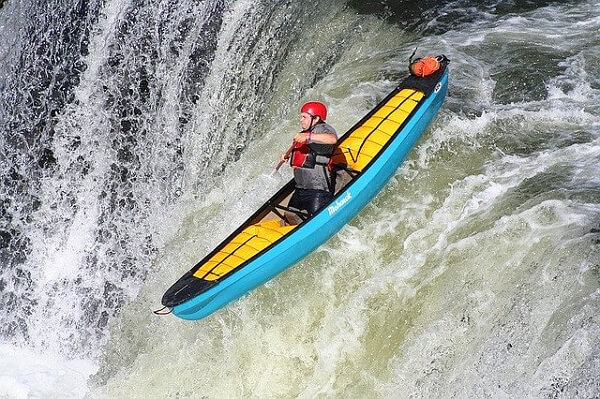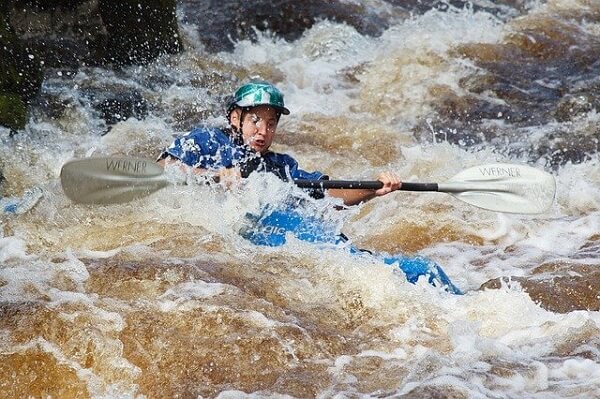Kayaking and canoeing come under the most exhilarating recreational activities. We cannot stop ourselves from kayaking in vacations or on holidays. Along with enjoyment comes responsibility. Kayakers must know certain ferry techniques that what should you do when approaching a low-head dam in a kayak or canoe? and prevent any accidents or potentially fatal situations. Most of the enthusiasts must have come across high tides, huge waves, deep waters, shallow waters, fast wind conditions, and a low-head dam.
It could be really fatal to someone if they approach a low-head dam. If you are a newbie -then you must study the river in which you are going for kayaking. Never underestimate the weather conditions as well. What’s a big deal in a low-head dam? One should know what a low-head dam is and how it can dangerous while kayaking or canoeing.
Let’s discuss what should you do when approaching a low-head dam in a canoe or kayak?
Page Contents
What To do when approaching a low-head dam kayak?
So you are kayaking in a river on a very fine day and seem to be enjoying the experience. You need to be very cautious regarding your ferry route and the consequences it would have. As know we have understood what a low-head dam is and how it can be fatal, here we are to provide you what should you do when approaching a low-head dam in a kayak or canoe?
Before stepping into the river
- Check the weather conditions, because it is advisable to not go kayaking after a heavy rainfall. Check with the currents and the tides of the river.
- Study the river thoroughly. You can even ask the supervisor or the invigilator regarding any low-head dams. If you are a newbie, it is highly recommended to know the area, weather condition and the river. You can refer to maps online and inquire with the locals.
- Wear a PFD- Personal Flotation Device or a life vest over your clothes so as to avoid any mishaps. This doesn’t mean to would be all-time safe; the hydraulic currents can pull you down even with a PFD. Hence avoid low-head dams.
- If possible keep a good rescuers team along with you, so that they can rescue you. But it is still a presumption because most of the rescuers have themselves been drawn into a hydraaulic boil. It is always advisable to avoid the low-head dam.
- Always check out for boards on the way down to the river.
After entering into the river
- Be aware and vigilant. Your vigilance can help you save your life.
- If you see a warning board that says “low-head dam ahead”, try to avoid going further and either paddle back to the shore or go to the nearest river shore. Mostly the maps show this sign, check out for it and avoid going there.
- When you encounter a low head dam, you can get out of your kayak and start walking in the water on the dam (if it’s not too deep) or you can swim through the river to the shore.
- Try to portage your kayak to the shore as well because it might break if let into the hydraulic boil. It needs knowledge of few techniques but it is not very difficult if you know how to. But it is advisable to save yourself first.
- If you know swimming, just dive deeper into to river and swim far away from the reverse cycle after being hit by a low-head dam. Diving deeper can help you break through the hydraulic boil. There is less water pressure below.
What to do when you don’t have any warning signs?
Here are the things to check on if you cannot see any signs on the river.
- Check the current below. Check if the water is suddenly speeding up down there. Take the hint and paddle back.
- It’s very hard to notice any low-head dam, check for small fall outs of water in between the river or any ditches.
- Be vigilant and awake.
- Be prepared to jump off the kayak. Hence wear a life vest or a PFD.
-
What’s a low-head dam
Let’s get into practical stuff now. What is a low head dam? As we all know a dam is built on a river for many purposes like hydropower, flood control, water-saving for agriculture and industries, electricity generation, etc. Dams could be of various sizes. Generally, the smallest size of the dams is very dangerous.
- Also Read: How To Tie Down A Kayak Without A Roof Rack
-
A low-head dam is built under a river and cannot be easily seen from the surface. The main purpose of building low- head dam is to raise the water level upstream on a river and extend the river’s length in order to reach far away from agricultural lands and villages. It is even called a weir and it holds back some water in order to produce hydropower. You can find a lot of such dams in the rivers. Next let’s see why is it fatal? As this is a serious topic, I have taken up this task to help you find answers to what should you do when approaching a low-head dam in a canoe or kayak?
The structure of the low-head dam could be seen as this way.
High-speed current drowning zone
The water when flows from above the dam, it falls down in fast motion and replaces the water beneath. This causes the beneath the water to come up and creates a reverse cycle of the water. This is known as hydraulic state or hydraulic “boil” cycle. The kayakers can find themselves in this state if they are unaware of the low-head dam.
Kayakers and boaters cannot judge the depth of the river and the dam, and as they come closer to the dam, the speed of water increases and the kayak speedily goes towards the dam. Hence there is a high possibility that they fall into the hydraulic. Kayakers can get trapped in the hydraulic currents and it can push them deeper into the river along with the kayaks or the boats. This can prove very fatal.
Conclusion
The most received advice is to avoid such low-head dams. You might be brave, but never underestimate the power of nature and such small glitches in the rivers. In this article, I have tried to suggest a few precautionary steps to be taken to avoid drowning in the river.
Hopefully you have got answers regarding what should you do when approaching a low-head dam in a kayak or canoe? Your safety is the priority and hence keep these suggestions in mind next you go for kayaking. I will keep updating more on such topics; do hang on to my website for more new stuff. If you have doubts regarding this article, feel free to comment below and I would try my best to answer them.





